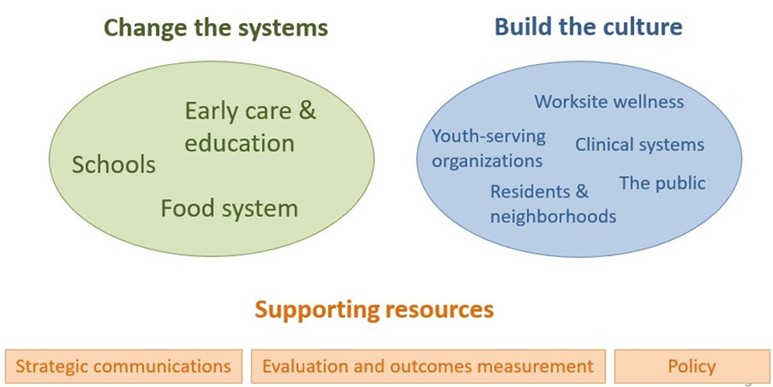Education and personal responsibility are critical elements of any program to reduce obesity, but not sufficient on their own. Additional interventions are needed that rely less on conscious choices by individuals and more on changes to the environment and societal norms. Such interventions ‘reset the defaults’ to make healthy behaviors easier. McKinsey Global Institute, Overcoming Obesity: An Initial Economic Impact (2014)
Mission
To create healthy places, neighborhoods, and communities where families have real opportunities to make healthy choices that promote their health, vitality, and well-being, including access to affordable, healthy food and meaningful opportunities to play and be active.
Solution: Comprehensive, multi-sector interventions work
The research demonstrates consistently that greater comprehensiveness, dose, and reach across policy, systems, and environments in multiple sectors at organizational, local, and state levels are associated with reduced childhood obesity prevalence in community-wide populations.[1]
Complementary research completed by Cindy Collier and Daphne Clark in 2011-13 also found that multi-sector, coordinated efforts across the community demonstrated success in moving the needle on childhood obesity, and recommended the same for central Indiana.

Policies Implemented
Jump IN for Healthy Kids was created to reduce the high prevalence of child overweight and obesity in central Indiana, an area facing profound health disparities and economic disadvantages. Bringing together stakeholders to form a comprehensive, multi-sector collective impact effort, Jump IN focuses on:
- changing the policies, practices, and environments in schools, child care facilities, and other places that influence the health behaviors of children and families
- addressing barriers to healthy food access and active living; and
- improving the overall culture of health in the community through public awareness and engagement.
Get the childhood obesity fact sheet, including what we can do to reduce the prevalence in central Indiana: download now